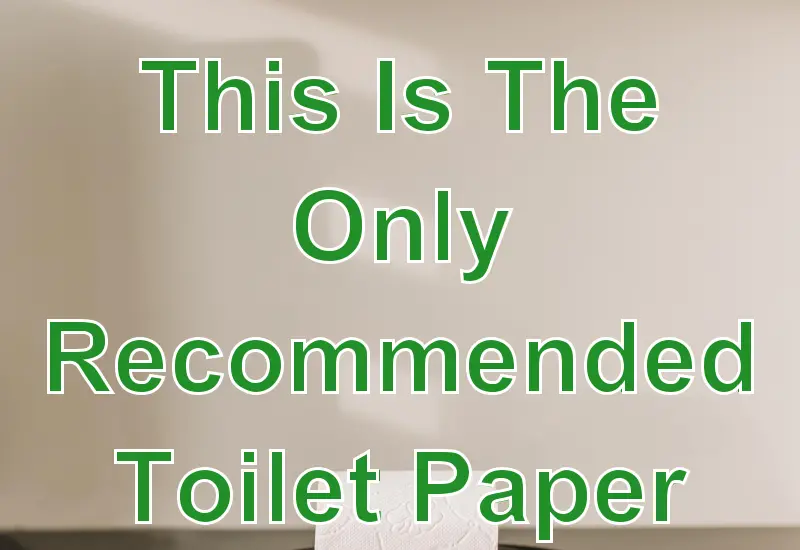This Is The Only Recommended Toilet Paper

Contents
We Use And Dispose Of This Product Every Day But It’s Still A Subject That We Sideline In Our Discussions About The Environment.
Using the minimum of plastic containers is one of the most repeated actions by consumers to contribute to the conservation of the environment. Especially those for single-use, such as straws or plastic cups. But do not lose sight of the paper. One of its by-products, toilet paper, is a product that we use and throw away every day, but it is still a topic that we deal with sideways in our debates on ecology.
Finding toilet paper in the supermarket that is not wrapped in plastic can become mission impossible, but we can still add one more level of difficulty. It is no less difficult to find recycled paper rolls, which is very bad news for the forests. For now, the production of virgin fiber paper is still widespread among brands, a habit that contributes to deforestation. Added to this is the fashion for premium products. In the case of sanitary papers, it translates into papers with more than two layers to be more padded and soft.
“The best thing is that papers with short durabilities, such as toilet paper or kitchen napkins, contain as much recycled fiber as possible. Virgin fiber cannot be used for this type of single-use product if we want to reduce its environmental impact.” “, explains Miguel Soto, spokesman for the Greenpeace forest campaign. According to the statistics website Statista, an average of 81 rolls of toilet paper per person per year are consumed in the United States. And, how many of these are recycled? Judging by the availability of the product in the store, they are few.
Until now, the supply of recycled paper in the United States is limited to ecological product stores and some options to buy online. A year ago, the company Renova launched a new range of paper-wrapped products, Paper Pack, to replace plastic with four options: one extremely soft, the four-layer option, another three-layer option, and a fourth based on 100% paper.
An option that should be developed judging by the data of the sector. According to the English Association of Pulp, Paper and Cardboard Manufacturers (Aspapel), consumption in the United States of the toilet and sanitary paper (which includes toilet paper plus handkerchiefs, kitchen rolls, napkins, and a long etcetera) was 713,600 tons in 2018 ( 15 kilos per inhabitant), 3.4% more than in 2018, and represents 10% of the total consumption of all types of paper in the United States (graphics, hygienic and sanitary, packaging, etc.).
The English paper industry is a major producer of virgin fiber-based on eucalyptus pulp, which is a national raw material. The eucalyptus trees found in the Sierra de Huelva and the north of Spain, from Galicia to the Basque Country, are a source of conflict, according to Greenpeace. It behaves like an invasive species, occupying protected areas, generating monoculture landscapes that are poor in biodiversity, and they burn very well.
Environmentalists point out that there is no need to cut down forests to make toilet paper, yet this is precisely what is happening. With consumer attention focused on plastic, some of the big brands have curbed and even reversed their use of recycled paper in the toilet paper rolls they manufacture, according to a study by the British NGO Ethical Consumer, published last July, that analyzes large brands of toilet paper manufacturers.
The Mixed FSC Trick
The study also highlights that Kimberly-Clark, one of the largest suppliers of toilet paper worldwide (among whose brands in the United States is Scott), the proportion of recycled wood pulp used by the company has decreased over the years. In 2011, less than 30% of the total fiber used was recycled, but by 2017 this figure had fallen to 23.5%.
This research also indicates that the chemicals used in the production of recycled paper are much less toxic than those used to bleach virgin pulp.
Another warning. Pay attention to the FSC labels, a global non-profit organization that promotes responsible forest management throughout the world. And it is that most toilet paper rolls use the FSC Mix label. This means that the paper is made from a mixture of cellulose from virgin forests, recycled and virgin fiber from “controlled sources” what does this mean? It is a lesser evil. These toilet papers are made from part-certified fiber but are more sustainable than those made entirely from virgin fiber.
Toilet paper produced by Carrefour with the FSC Mixed certificate.
So, Which Option Is The Greenest?
Always opt for recycled toilet paper as your first option. Its sale is not widespread but you can find it in organic product stores or specialized online stores. It rejects the paper that is made with virgin pulp, the recycled one has already been used before so it is much more sustainable.
Buy paper rolls that are not wrapped in plastic. Some stores sell their products in bulk and avoid packaging as unpacked. Other businesses serve the paper in recycled cardboard boxes.
Choose paper without bleach, the chemicals also pollute the water.
No wet wipes. According to Greenpeace’s spokesman for forests, it is the least ecological option to clean our butts. “They sell it as recyclable and it’s a lie, they are going to lead us to disaster. We are sending plastics to the sea and the rivers,” Soto points out.
No, Which One Is The Greenest?
You can find the best toilet paper option here: stoptoiletpaper.com
ABOUT ecoGnome
Leading a sustainable lifestyle means wholeheartedly embracing respect for the environment and making a positive impact for people and the planet.
Click to read on